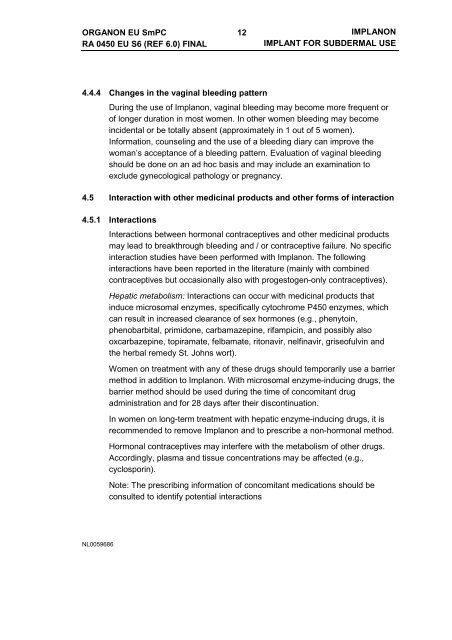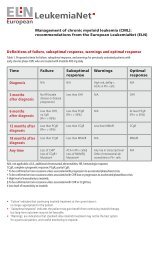IMPLANON IMPLANT FOR SUBDERMAL USE ... - epgonline.org
IMPLANON IMPLANT FOR SUBDERMAL USE ... - epgonline.org
IMPLANON IMPLANT FOR SUBDERMAL USE ... - epgonline.org
You also want an ePaper? Increase the reach of your titles
YUMPU automatically turns print PDFs into web optimized ePapers that Google loves.
ORGANON EU SmPC<br />
RA 0450 EU S6 (REF 6.0) FINAL<br />
12<br />
<strong>IMPLANON</strong><br />
<strong>IMPLANT</strong> <strong>FOR</strong> <strong>SUBDERMAL</strong> <strong>USE</strong><br />
4.4.4 Changes in the vaginal bleeding pattern<br />
During the use of Implanon, vaginal bleeding may become more frequent or<br />
of longer duration in most women. In other women bleeding may become<br />
incidental or be totally absent (approximately in 1 out of 5 women).<br />
Information, counseling and the use of a bleeding diary can improve the<br />
woman’s acceptance of a bleeding pattern. Evaluation of vaginal bleeding<br />
should be done on an ad hoc basis and may include an examination to<br />
exclude gynecological pathology or pregnancy.<br />
4.5 Interaction with other medicinal products and other forms of interaction<br />
4.5.1 Interactions<br />
Interactions between hormonal contraceptives and other medicinal products<br />
may lead to breakthrough bleeding and / or contraceptive failure. No specific<br />
interaction studies have been performed with Implanon. The following<br />
interactions have been reported in the literature (mainly with combined<br />
contraceptives but occasionally also with progestogen-only contraceptives).<br />
Hepatic metabolism: Interactions can occur with medicinal products that<br />
induce microsomal enzymes, specifically cytochrome P450 enzymes, which<br />
can result in increased clearance of sex hormones (e.g., phenytoin,<br />
phenobarbital, primidone, carbamazepine, rifampicin, and possibly also<br />
oxcarbazepine, topiramate, felbamate, ritonavir, nelfinavir, griseofulvin and<br />
the herbal remedy St. Johns wort).<br />
Women on treatment with any of these drugs should temporarily use a barrier<br />
method in addition to Implanon. With microsomal enzyme-inducing drugs, the<br />
barrier method should be used during the time of concomitant drug<br />
administration and for 28 days after their discontinuation.<br />
In women on long-term treatment with hepatic enzyme-inducing drugs, it is<br />
recommended to remove Implanon and to prescribe a non-hormonal method.<br />
Hormonal contraceptives may interfere with the metabolism of other drugs.<br />
Accordingly, plasma and tissue concentrations may be affected (e.g.,<br />
cyclosporin).<br />
Note: The prescribing information of concomitant medications should be<br />
consulted to identify potential interactions<br />
NL0059686
















